|
Morwenstow
Morwenstow () is a civil parish in north Cornwall, England, United Kingdom. The parish abuts the west coast, about six miles (10 km) north of Bude and within the Cornwall Area of Outstanding Natural Beauty (AONB). Morwenstow is the most northerly parish in Cornwall. As well as the churchtown (a hamlet called Crosstown), other settlements in the parish include Shop, Woodford, Gooseham, Eastcott, Woolley and West Youlstone. The population at the 2011 census was 791. Morwenstow parish is bounded to the north and east by parishes in Devon, to the south by Kilkhampton parish and to the west by the Atlantic. The River Tamar has its source at a spring on Woolley Moor, at , which is in the parish near the border with Devon. Morwenstow is the one-time home of the eccentric vicar and poet Robert Stephen Hawker (1803–1875), the writer of Cornwall's anthem '' Trelawny''. Hawker is also credited with reviving the custom of Harvest Festivals. Parish church T ... [...More Info...] [...Related Items...] OR: [Wikipedia] [Google] [Baidu] |
Church Of St Morwenna And St John The Baptist, Morwenstow
The Church of St Morwenna and St John the Baptist is the parish church of Morwenstow, north Cornwall, England, United Kingdom, the most northerly parish in Cornwall. The church is dedicated to Morwenna, a local saint, and to John the Baptist, and is recorded in the National Heritage List for England as a designated Grade I Listed building#England and Wales, listed building. It is an active Anglican parish church in the diocese of Truro, the archdeaconry of Bodmin, and the deanery of Stratton. Its benefice is combined with that of St James, Kilkhampton to form the United Benefice of Kilkhampton with Morwenstow. From 1835 to 1874 the vicar of the parish was Robert Stephen Hawker, Rev. R. S. Hawker, poet and antiquary who is credited with creating the modern form of the harvest festival church service to give thanks for a good harvest in 1842. The church stands in a remote position near cliffs on the north coast of Cornwall. Amongst the tombs and gravestones in the churchyard ... [...More Info...] [...Related Items...] OR: [Wikipedia] [Google] [Baidu] |
Robert Stephen Hawker
Robert Stephen Hawker (1803–1875) was a British Anglican priest, poet, antiquarian and reputed eccentric, known to his parishioners as Parson Hawker. He is best known as the writer of " The Song of the Western Men" with its chorus line of "And shall Trelawny die? / Here's twenty thousand Cornish men / will know the reason why!", which he published anonymously in 1825. His name became known after Charles Dickens acknowledged his authorship of "The Song of the Western Men" in the serial magazine ''Household Words''. Biography Hawker was born in the clergy house of Charles Church, Plymouth, on 3 December 1803. He was the eldest male of nine children and grandson of Robert Hawker, vicar of Charles Church. When he was about ten years old his father, Jacob Stephen Hawker, took Holy Orders and left Plymouth to become curate of Altarnun, leaving him in the care of his grandparents. By this time Hawker was already reading and writing poetry. He was educated at Liskeard Grammar S ... [...More Info...] [...Related Items...] OR: [Wikipedia] [Google] [Baidu] |
Morwenna
Morwenna is the eponymous patron saint of Morwenstow, a civil parish and village in north Cornwall, UK. Her name is thought to be cognate with Welsh '' morwyn'' "maiden", although the first name is also used in Wales and Brittany and said to be composed of "Mor" and "Gwenn", meaning "White sea" in both Welsh and Breton. Life Morwenna first appears in a 12th-century life of Saint Nectan that lists her alongside Endelient, Mabyn and Menfre (among many others) as a daughter of the Welsh king Brychan. Orme, Nicholas (2000). , Oxford University Press, p. 196. She was trained in Ireland before crossing over to Cornwall. Morwenna made her home in a little hermitage at Hennacliff (the Raven's Crag), afterwards called Morwenstow (meaning "Morwenna's holy-place"). It stands near the top of a high cliff overlooking the Atlantic Ocean, where the sea is almost constantly stormy, and from where, in certain atmospheric conditions, the coast of Wales can be seen. She built a church ther ... [...More Info...] [...Related Items...] OR: [Wikipedia] [Google] [Baidu] |
Caledonia (1839 Brig)
The ''Caledonia'' was a brig of some 200 tons (bm), built in Arbroath, Scotland, and wrecked on 7 September 1842 on Sharpnose Point, near Morwenstow, Cornwall. Final voyage In September 1842 the ''Caledonia'' was homeward bound from Odesa, and called in at Falmouth, Cornwall, Falmouth to bury a crewman who had died of wounds suffered during a knife fight in Constantinople. The ''Caledonia'' then sailed for Gloucester to unload her cargo of wheat. As she departed Falmouth a north-westerly gale was raging. At about 1 am on the morning of 8 September the ship's lookout saw waves breaking to Windward and leeward, leeward on Sharpnose Point, near Morwenstow, Cornwall. Her captain, Stevenson Peter, shortened sail and tried to stand clear of the shore, but the ship refused to come up and soon hit the rocks at Sharpnose Point. As they hit, the captain ordered the crew to climb into the rigging, but the mast collapsed, throwing them into the sea where they all died. The sole survivor ... [...More Info...] [...Related Items...] OR: [Wikipedia] [Google] [Baidu] |
Hawker's Hut
Hawker's Hut is an historic hut at Morwenstow, Cornwall originally built by the eccentric clergyman, poet and antiquarian, Robert Stephen Hawker (1803 – 1875), close to Higher Sharpnose Point. The hut is located approximately 1 mile from Morwenstow Church. The hut is mainly of timber construction and is partially built into the hillside (earth sheltered) with a turf roof. It was originally built from driftwood and timber retrieved from shipwrecks by the eccentric vicar and poet. Parson Hawker spent many hours in the hut writing poems and smoking opium, perhaps inspired by the views of the Atlantic Ocean. Visitors to the hut during Hawker's time there included Alfred Tennyson in 1848 (with whom Hawker toured Tintagel) and Charles Kingsley. Today the hut is accessible on foot from the coastal footpath via a short set of steps. Hawker's hut has been maintained since its original construction although some of the original elements are still present. It is currently the smalle ... [...More Info...] [...Related Items...] OR: [Wikipedia] [Google] [Baidu] |
West Youlstone
West Youlstone is a hamlet in north Cornwall, England, United Kingdom. It lies seven miles north north west of Bude and north of Kilkhampton along the A39 road. It belongs to the parish of Morwenstow, and lies to the east of it. East Youlstone is immediately to the east but is in Devon. History Archaeological discoveries on the site have revealed it was occupied in the Bronze Age. It is mentioned in the memoirs of James Thorne of Shebbear Shebbear (; ) is a village and civil parish in the Torridge district in Devon, England. History Shebbear was the third-largest settlement recorded in North Devon in the Domesday Book, having 76 households, 20 of which were slaves. It was unusu .... References Hamlets in Cornwall Morwenstow {{Cornwall-geo-stub ... [...More Info...] [...Related Items...] OR: [Wikipedia] [Google] [Baidu] |



